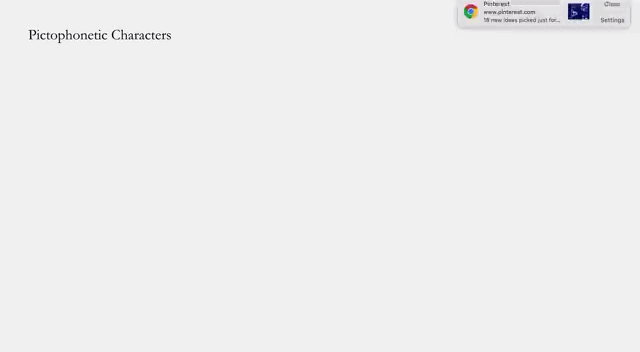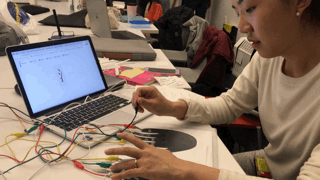DESIGN SUMMARY
Square Graphy is an interactive installation to create experimental Chinese Character. I am exploring a way to raise people’s awareness to feel the structure, feature, and artistry of Chinese characters. This project aims to bring Chinese ideogram with universal and aesthetic purpose under the influence of the information age.
DEFINE PROCESS
Background Research
· The feature and the structure of Chinese characters
It is widely noticed that Chinese is pictographic. At present, the total number of Chinese characters has exceeded 80,000, with 3,500 commonly used characters. Chinese characters are based on "pictographs". However, pictographic characters are very limited. Abstract things in nature and human society cannot be copied and painted. Actually, more than 80% of Chinese characters are pictophonetic characters.

Pictophonetic characters are characters composed of two parts: a pictographic element, which is a “radical” indicating the meaning of the character, and a phonetic one which is a “single character” indicating pronunciation.
For example, the word has a “water” “氵” radical is associated with water.
· Keyboard and typing system for the Chinese language
Since the 19th century, a series of information and language technologies have emerged: telegraphy, typewriting, word processing, personal computers and more. These technologies have revolutionized the way people communicate and the way we manage our everyday lives. But they all have one major drawback: they were almost all invented in the west and deal mainly with Roman letters.

For the Chinese system, how to use dozens of keyboards to arrange thousands of Chinese characters has become the most difficult problem.
Early Chinese typewriters still had hundreds of keyboards. However, depending on the feature of the Chinese character, the number of keyboards was reduced by the use of radicals as categories.

In 1954, “Hanyu Pinyin System” is formed on the basis of dozens of phonetic systems. Its basic feature is "three changes", namely Roman change, phoneme change, colloquial change. One of the most important is the widely used international Roman alphabet, in the letter application to the maximum close to international habits.

After the popularization of “Hanyu pinyin system”, for Chinese speakers can use the qwerty keyboard to type easily.
Problem
In the information age, with the popularity of smartphones, computers and other electronic products, Chinese character writing has been replaced by various input methods, which leads to the reduction of writing opportunities of Chinese characters.Because of the long-term use of computers, many people can only roughly remember the shape of Chinese characters, but can not correctly write the specific radicals and structure with pens.
Therefore, in the age of touch screens and keyboards, what will happen to Chinese characters? If the unique structure of Chinese character will gradually disappear in the age of information?
Prototype 1

· Canvas
In order to make people understand the special structure of Chinese pictophonetic characters, I keep the radical part as a “rule” for the user to choose a meaning for their own characters.
This made non-Chinese speakers easier to understand the meaning of Chinese characters.


· Keyboard
By investigating the frequency of input of Roman letters in English, it can be found that when we are typing, almost every finger corresponds to a letter with high typing frequency. Therefore, I created a finger keyboard. I like to use the muscle memory of users to input Roman letters to generate the corresponding Chinese stroke.
At the same time, I chose the most basic 8 strokes of Chinese as the creation element, and matched the Roman letters with each stroke, so that users could create by entering words with corresponding strokes.


Prototype 2
Through prototype1 user tests, I found that the first version of the keyboard didn't have a strong connection with Roman typing. Many tester muscle memories of the QWERTY keyboard are not reflected on the finger keyboard, and most tester still selects specific strokes to create the keyboard. Meanwhile, the basic eight strokes cannot satisfy the "Phonetic Element" part as an artistic creation.


So, based on the finger keyboard, I changed the stroke order based on the number of strokes generated from each base stroke and the number of letters based on each finger. On this basis, a new stroke keyboard based on QWERTY keyboard was created according to the typing frequency of Roman letters and stroke frequency.
Final Delivery
The final delivery is an interactive website with a physical stroke keyboard.The player can both choose use their muscle memory to typing based on Roman letters or just see the stroke on the keyboard to create.


DESIGN PROCESS
FUTURE & CONCLUSION


I made posters of the new water-related Chinese characters created by my testers. For the future, I hope to have the opportunity to display "SquareGraphy" as an installation. I wish that by introducing the special structure of Chinese characters, visitors can feel the culture of Chinese characters and actually create some structures of Chinese characters that they think are beautiful hieroglyphic Chinese characters
The project "SquareGraphy" is a deeper exploration of Chinese character culture. As a Chinese speaker myself, I am also deeply aware that under the influence of the information age, more and more young people have less understanding of this unique structure of Chinese characters. Facing the crisis of Chinese character culture, I believe "SquareGraphy" is a good attempt to attract people from different cultural backgrounds to feel Chinese characters. Although "SquareGraphy" is not a teaching tool, it gives participants an experience of the special structure of Chinese characters to some extent.


